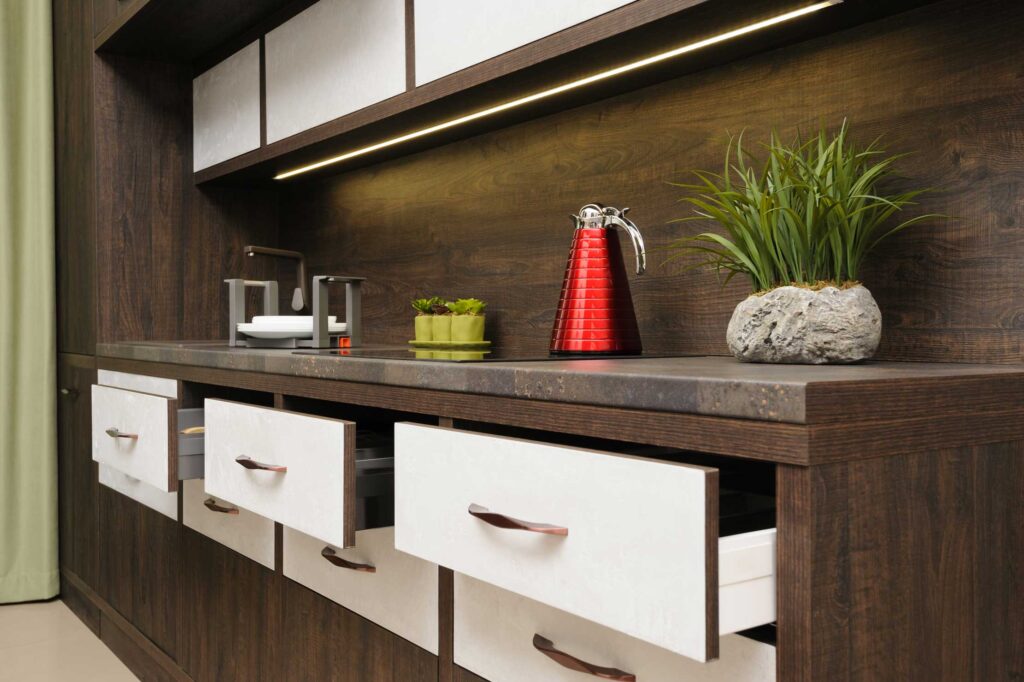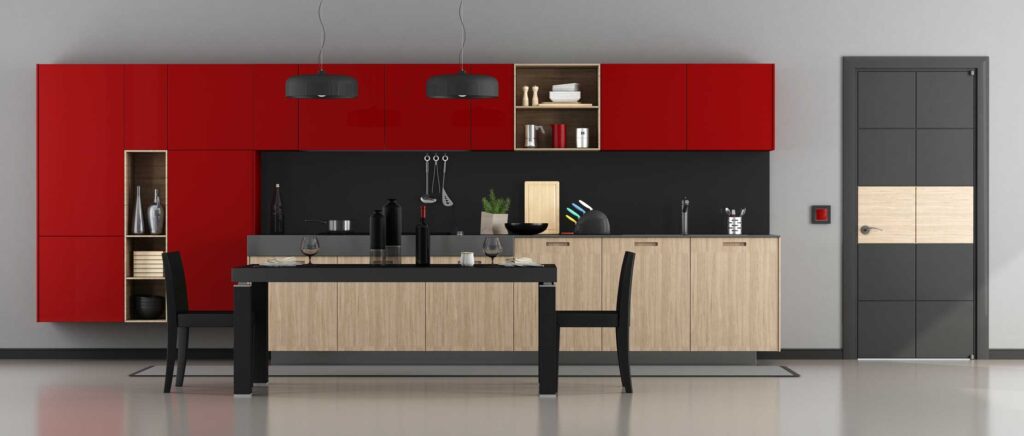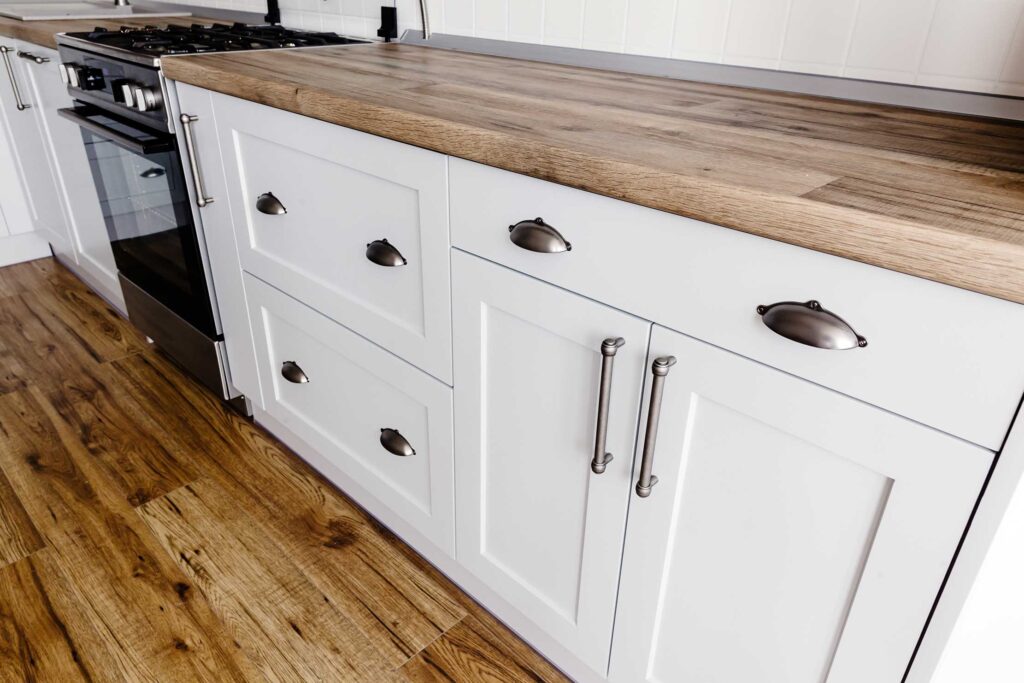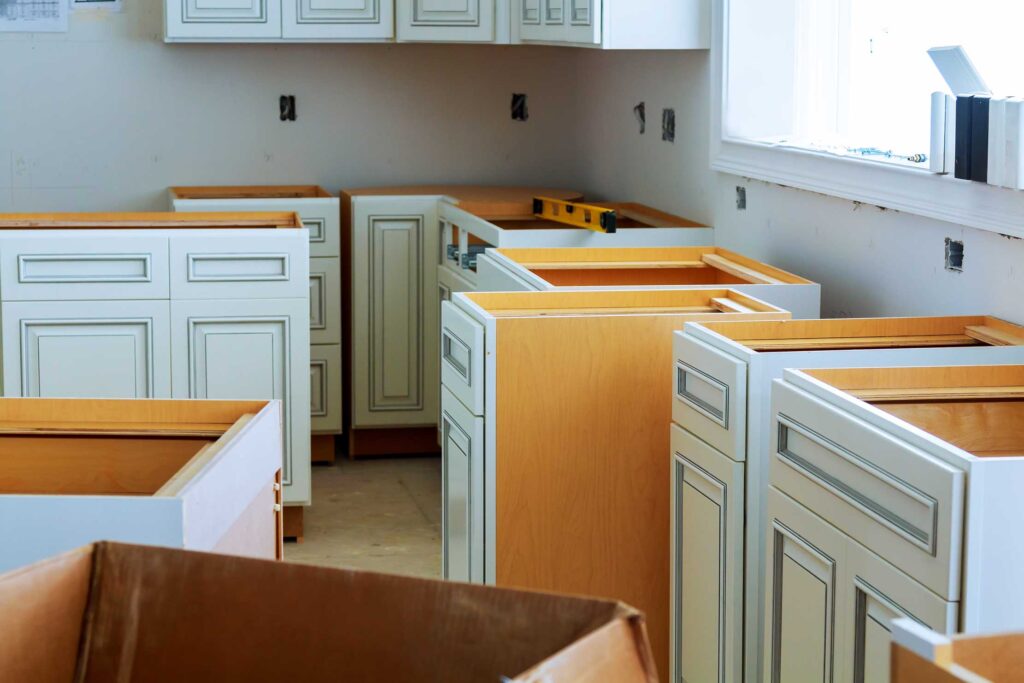Kitchen cabinets can eat up 40-50% of your kitchen renovation budget. This might surprise you.
These vital kitchen elements are your biggest investment in most kitchen remodeling projects. Your kitchen cabinet styles shape your space’s esthetics, functionality, and storage capacity. The price range varies widely – stock cabinets start at $150 per linear foot, while custom options can reach $1,200 per linear foot. Your dream kitchen needs the right cabinet style.
Choosing between different types of kitchen cabinets might seem daunting. Each type – from stock and semi-custom to fully custom options – brings its own advantages for durability, customization, and cost. This piece will help you understand your options and make a smart choice.
Let’s take a closer look at the perfect cabinet styles for your kitchen!
Understanding Different Types of Kitchen Cabinets
Your kitchen cabinet choice is one of the most important decisions you’ll make as you begin your renovation. Cabinet style shapes your kitchen’s look and determines how much storage space you’ll have.
Stock vs. Semi-Custom vs. Custom Cabinets
Kitchen cabinets come in three main categories, each with different customization options and price points:
Stock Cabinets:
These ready-made cabinets come in standard sizes and styles. They are the most affordable option. Stock cabinets start at about $80 per linear foot and you can pick them up right away or get them delivered within 3 days. They cost less but have fewer design choices and don’t last as long since they’re often made with particle board.
Semi-Custom Cabinets:
These cabinets strike a balance between stock and custom options. They cost between $100 and $650 per linear foot and let you adjust certain measurements and pick from more finishes and door styles. You can get semi-custom cabinets in 1-2 weeks or 4-8 weeks for more detailed work.
Custom Cabinets:
These cabinets are built just for your space. They cost $500 to $1,200 per linear foot but give you complete design freedom. Custom work takes 6-8 weeks for delivery but can last over 25 years, compared to 10-15 years for pre-made options.

Base, Wall, and Tall Cabinet Options
Kitchen cabinets fall into different groups based on where they go and what they do:
Base Cabinets:
These sit on the floor and support your countertops and sinks. Standard base cabinets are 24 inches deep and 34.5 inches tall. With a 1.5-inch countertop, they create the standard 36-inch counter height. You can get them in widths from 6 to 48 inches. They store your cookware and small appliances.
Wall Cabinets:
These mount above your countertops. They’re usually 12 inches deep but can range from 12 to 24 inches depending on placement. Heights vary from 12 to 42 inches. Most kitchens use 30-36 inch cabinets.
Tall Cabinets:
These floor-to-ceiling units give you lots of vertical storage. They stand 84 to 96 inches tall and are 12 to 24 inches deep. They work great for storing food, small appliances, and cleaning supplies.
Specialty Cabinet Solutions
Some cabinet types help you make the most of unique spaces:
Corner Cabinets:
Lazy Susans and diagonal cabinets help you use corner spaces better.
Pull-Out Systems:
These make it easy to reach items in deep cabinets, from spices to trash bins.
Appliance Garages:
These cabinets keep small appliances hidden but easy to reach.
Cabinet makers also offer extras like drawer dividers, plate organizers, and utensil trays that help keep your storage spaces neat and organized.
Professional installation is worth the investment, especially for semi-custom and custom cabinets. DIY might seem cheaper, but pros ensure everything fits and works properly.
Your final cabinet choice should match your budget, timeline, and customization needs while fitting your kitchen’s style. Take time to explore all options before deciding.
Assessing Your Kitchen Needs and Space
You need to understand your space and personal needs before picking kitchen cabinet styles. A full picture of your kitchen will help you make smart decisions about cabinet types, placement, and organization.
Measuring Your Kitchen Space
Accurate measurements are the life-blood of successful cabinet selection. Here’s how to capture your kitchen’s dimensions:
- Create a rough sketch of your kitchen layout, labeling each wall with a letter or number
- Measure the overall length of each wall, working clockwise around the room
- Record vertical measurements from floor to windowsill, windowsill to top of window, and floor to ceiling
- Mark the centerline of permanent features including sinks, windows, doors, and outlets
- Note the location of utilities, including water lines, gas lines, and electrical outlets
Small measurement errors can make beautiful cabinets unusable in your space. A professional’s help will give you precise measurements at this critical step.

Evaluating Storage Requirements
Your storage solutions depend on what you currently keep in your kitchen. Start by taking stock of your kitchen items and their sizes. Here’s how to maximize efficiency:
Items you use more than twice weekly should sit at eye level for easy access. Keep heavy items weighing over 5 pounds below eye level to stay safe. Take an honest look at your current cabinet usage and focus on what works rather than what you wish worked.
Well-organized zones can turn chaotic spaces into functional systems. Modern kitchens work best with five main zones: consumables, non-consumables, cleaning, preparation, and cooking. Smart zone placement streamlines your workflow and helps you discover the full potential of your storage space.
Considering Your Cooking Habits
Your cooking style changes everything about cabinet selection and layout. The classic kitchen work triangle connects your sink, refrigerator, and stove. This is a big deal as it means that the total distance between these elements shouldn’t exceed 26 feet. Different cabinet styles work better for different cooking styles:
Dedicated baking zones with special storage for sheet pans and ingredients work great for passionate bakers. Families with multiple cooks need 48 inches of aisle space, while single cooks can work with 42 inches. Varied cabinet heights and door styles make serving and presentation easier for frequent entertainers.
Your kitchen cabinet styles should match how you actually use your kitchen, not your aspirations. Honest assessment of your cooking frequency, style, and storage needs leads to cabinet choices you’ll love every day instead of regretting for years.
Exploring Popular Cabinet Door Styles
Your kitchen cabinet’s door style sets the tone for your entire kitchen design and shapes how the space looks and feels. The right choice comes from knowing each style’s unique features that line up with your priorities and daily needs.
Shaker Style: Timeless and Versatile
Shaker-style cabinets top the popularity charts with their clean, simple lines that never go out of style. These cabinets showcase a five-piece door design with a recessed center panel surrounded by four raised pieces – two stiles and two rails. The Shaker religious community created this minimalist design in the 1700s, and it blends well with any kitchen décor. You’ll find these cabinets work great in farmhouse, transitional, and midcentury modern designs. They come in various wood types like maple, cherry, oak, and birch, with options for beveled edges or routed details.
Flat Panel: Modern Minimalism
Flat-panel cabinets, also known as slab doors, show off smooth, clean surfaces without any frames or panels. Their simple style creates sleek lines that fit modern kitchens perfectly. Craftsmen make these from high-quality plywood, then paint or cover them with wood veneer. The plain surface lets unique hardware stand out. These cabinets cost less than other styles, though final prices depend on materials and hardware choices. The horizontal or vertical grain patterns are easy to clean since there’s no dirt-trapping grooves.
Raised Panel: Traditional Elegance
Raised panel cabinets bring refined, traditional beauty to your kitchen. The center panel sits level with or above the frame, which adds depth to your kitchen design. These cabinets often feature decorative edges and grooved outer rims that create an upscale look. Their colonial-era roots make them timeless rather than just trendy. Cherry, oak, or pine materials work great in traditional layouts and fit well in transitional or rustic country settings with the right hardware.
Glass-Front: Display and Visual Space
Glass-front cabinets reflect light and make kitchens feel larger. You can choose clear, frosted, textured, or stained glass to display your favorite dishes and decorative items. Different glass patterns and in-cabinet lighting boost their visual appeal. While they need more cleaning and organization, these cabinets smoothly mix open and closed storage. Many homeowners put glass doors on upper cabinets and solid doors below to create balance.
Beadboard: Cottage Charm
Beadboard cabinets stand out with their vertical wood slats and continuous grooves spaced every few inches. This textured style adds character that fits cottage, farmhouse, or beach-inspired designs perfectly. French country interiors started the trend, but now these cabinets work in modern settings too. Paint or stain them to match your color scheme, and pair them with distressed finishes and wrought iron hardware for a rustic feel. Professional cabinet installers should handle the installation to ensure everything fits correctly.

Selecting the Right Cabinet Materials
Your kitchen cabinet’s material choice will affect its durability, looks, and cost. You need to know the pros and cons of each option in today’s market to make a smart choice.
Wood Types and Their Characteristics
Natural wood stands out as a favorite for kitchen cabinet styles. Each wood type brings something special to the table:
Maple
hits 1450 on the Janka hardness scale, which makes it tough enough for busy kitchens. Its smooth grain and creamy white color help it fight off moisture and stains. The sun might darken it over time though.
Oak
cabinets are built to last with a 1290-1360 Janka rating. Red oak shows off bold grain patterns with reddish hints. White oak’s lighter look comes with a smoother feel and fights rot better than its red cousin.
Cherry
starts as light golden pink and grows into rich, reddish-brown shades as time passes. Cherry might be a softer hardwood, but its natural aging makes it perfect when you want a clear coat instead of dark stains.
Engineered Materials: MDF, Plywood, and Particleboard
Plywood‘s
strength comes from wood veneers glued with opposing grain patterns. It’s the top pick among engineered options and handles humidity changes better than solid wood.
MDF
(Medium-Density Fiberboard) blends wood fibers with wax and resins. You’ll get a smooth, even surface that takes paint beautifully, but watch out for water damage.
Particleboard
mixes sawdust and wood scraps with resin to create the most budget-friendly choice. The trade-off is its lower density, which means less strength and moisture resistance.
Alternative Materials: Metal, Acrylic, and Laminate
Stainless steel
cabinets are tough as nails and shrug off moisture, heat, and stains. They work great in industrial or modern kitchens and stay clean easily. Just be ready to wipe off fingerprints now and then.
Acrylic
cabinets bring bold colors with glossy finishes that handle scratches better than most other materials. Modern kitchens love their smooth, non-toxic surfaces.
Thermofoil
wraps MDF in PVC vinyl through heat and vacuum pressure. This creates a seamless look that holds up better than paint during daily use.
Whatever material catches your eye, professional installation is your best bet to ensure everything fits right and lasts long.

Choosing Finishes and Hardware
Cabinet finishes and hardware work like jewelry for your kitchen cabinets. They will give a better look and make them more functional. Your chosen cabinet styles can look amazing with the right combination that shows your personal style and matches your home’s look.
Paint vs. Stain: Pros and Cons
Painted and stained cabinets create two very different looks. Paint gives you a smooth, solid finish that covers the wood grain and creates a clean, modern look. Painted cabinets cost 10-15% more than stained ones. Notwithstanding that, paint lets you pick bright colors you can’t get with stains.
Stained cabinets show off the natural beauty of wood grain and texture. Stains soak right into the wood surface and create a see-through finish that brings out each cabinet door’s unique features. It also holds up better against daily use. These finishes last much longer—20-30 years compared to paint’s 10 years.
Stain’s toughness makes it easier to fix up and less likely to chip, which helps with upkeep. Paint needs more careful handling but can make MDF (medium-density fiberboard) look just like real wood.
Hardware Styles That Complement Your Cabinets
Kitchen hardware does more than just look good—it’s something you touch often, so it needs quality materials and smart choices. These pieces are like jewelry that can lift even basic cabinetry.
Traditional cabinets look great with hammered knobs and pulls you might see in Tudor-style homes. Mixed metals work well in transitional kitchens—try brass knobs on doors with nickel pulls on drawers. Simple, modern cabinets match perfectly with smooth tubular pulls or built-in handles.
White metal finishes like pewter, nickel, and white bronze are coming back strong in 2025. Sand-cast hardware with rough textures adds an artistic touch to cabinets.
Color Trends and Timeless Options
Colors come and go, but some cabinet finishes stay popular forever. White and off-white cabinets rule kitchen designs, but designers warn against yellowish whites that look old fast. Black and navy blue are sophisticated choices that designers say will always look good.
Natural wood cabinets with clear stains are becoming more popular in 2025. This fits with the bigger trend toward warm neutrals like taupe, greige, and cashmere.
Designers suggest these finish sheens:
- Satin: Fights stains better than duller finishes while looking smooth and hand-rubbed
- Semi-Gloss: Adds subtle depth and remains a top choice
- High-Gloss: Creates a mirror-like surface that’s both striking and tough
Whatever finish or hardware you pick, professional installation will give you high-quality results that make your kitchen cabinet styles look better for years.
Working with Kitchen Design Professionals
Working with kitchen design professionals makes your cabinet selection experience simple and efficient. These experts will guide you through the best cabinet options that match your needs and space, rather than leaving you to navigate countless styles by yourself.
Benefits of Professional Cabinet Installation
Cabinet installers bring years of specialized experience to your kitchen project. They know how to handle uneven walls and other complex issues that pop up during installation. Their careful work will protect your beautiful new kitchen cabinets from scratches, chips, or damage during setup.
Professional installation keeps you safe, which is a vital advantage. Kitchen cabinets can be extremely heavy. DIY installation attempts without proper experience could lead to serious injuries. Professional installation also prevents mistakes that might get pricey to fix later.
What to Expect During Consultation
Your first cabinet consultation sets the stage for your project’s success. Designers usually start by learning about your vision and goals for the space. You should bring kitchen design images that show your preferred style.
The designer will want to know your current kitchen’s strengths and weaknesses, plus your cooking habits. This helps them understand how you use your space. Most consultations include initial measurements, though final ones happen before ordering.
You’ll see various cabinet door styles, finishes, and organizational features that match your needs. Many designers create 3D renderings to help you picture your kitchen before installation starts.

Questions to Ask Your Cabinet Designer
These questions will help you get the most from your consultation:
- What materials do you recommend for our cabinet boxes and doors?
- Can you provide a detailed timeline for the whole project?
- What internal organization solutions do you offer for our specific storage needs?
- Do you handle all aspects of installation, or work with subcontractors?
- What’s your warranty coverage, and how do I get service under that warranty?
Kitchen cabinet professionals are a great way to get your ideas transformed into functional, beautiful spaces. Their expertise helps avoid costly mistakes and ensures you’ll achieve your dream kitchen.
Pick The Best Kitchen Cabinet!
Your kitchen cabinet style choice stands out as a key decision in your renovation journey. In this piece, we’ve covered everything from cabinet types and materials to finishes and hardware options that will help you build your dream kitchen.
Kitchen cabinets make up almost half of your renovation budget, making smart choices is vital. Stock cabinets give you affordability, semi-custom options offer flexibility, and custom cabinets provide complete personalization. Each type brings its own set of advantages to think over.
Expert designers and installers are a great way to get guidance when making these choices. Their specialized knowledge helps you avoid getting pricey mistakes and ensures proper fit and finish. Their experience with materials of all types, from classic hardwoods to modern engineered options, will give your cabinets lasting durability.
Take time to evaluate your specific needs, space requirements, and style priorities before making final decisions. See how different cabinet door styles, materials, and finishes line up with your cooking habits and storage needs. Smart planning now creates a kitchen that works perfectly for years ahead.
FAQs
Q1. What are the main types of kitchen cabinets available?
There are three main types of kitchen cabinets: stock, semi-custom, and custom. Stock cabinets are pre-manufactured and budget-friendly, semi-custom offer more flexibility in design, and custom cabinets provide unlimited design possibilities but are the most expensive option.
Q2. How do I choose the right cabinet material for my kitchen?
Consider factors like durability, appearance, and budget. Natural woods like maple and oak offer durability and classic looks. Engineered materials like MDF and plywood provide strength and moisture resistance. Alternative materials such as stainless steel or acrylic suit modern designs and offer unique benefits.
Q3. What’s the difference between painted and stained cabinet finishes?
Painted cabinets offer a uniform, opaque finish that conceals wood grain and provides vibrant color options. Stained cabinets showcase the natural wood grain and texture, are more durable, and easier to touch up. Paint typically lasts about 10 years, while stains can last 20-30 years.
Q4. How important is professional cabinet installation?
Professional installation is crucial for ensuring proper fit, alignment, and durability of your cabinets. Experts can handle complexities like uneven walls, prevent damage during installation, and avoid costly mistakes. Their experience is especially valuable for semi-custom and custom cabinets that represent a significant investment.
Q5. What should I consider when selecting cabinet hardware?
Choose hardware that complements your cabinet style and overall kitchen design. Consider the finish (e.g., brass, nickel, pewter), style (traditional, modern, transitional), and functionality. Remember that hardware is a high-touch surface, so quality is important. Mixing metals can add interest to transitional kitchens, while sleek, minimalist hardware suits modern designs.
